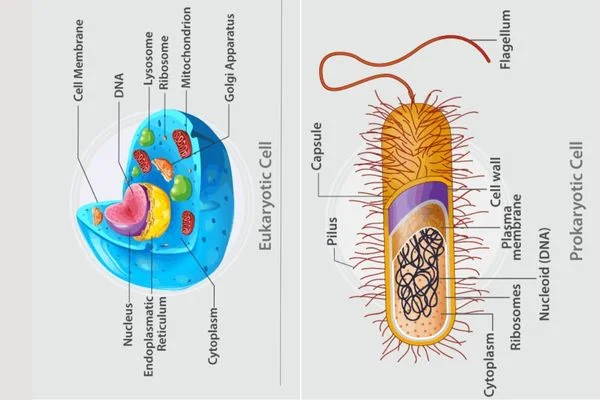
Source: Foxtechview.com
Introduction
One of the most basic biology-related distinctions is the one between prokaryotes and eukaryotes. The two categories are the fundamental structural organization of forms of life on Earth. Both of them are the building blocks of living organisms, but at the same time, their internal architecture, complexity and functions vary greatly. Such differences are key to the learning of evolution, microbiology and cell biology. Prokaryotes vs Eukaryotes
Defining Prokaryotes and Eukaryotes
Prokaryotes, are unicellular organisms that do not have a veritable nucleus and membrane-enclosed organelles. Their genetic material is packaged into one circular DNA molecule that is found within a region referred to as nucleoid. This is the case of bacteria and archaea, which are one of the oldest and simple forms of life, dating back to over 3.5 billion years ago.
Eukaryotes, on the other hand, are organisms in which the cells are membrane-enclosed by a nucleus and have other organelles like mitochondria, endoplasmic reticulum and Golgi apparatus. These are protists, fungi, plants and animals. Eukaryotic cells are said to be more developed as they sustain monocellular as well as multicellular organisms.
Structural Differences
The most obvious distinction between prokaryotes and eukaryotes is the cell structure:
Nucleus
Prokaryotes: A free floating nucleus is absent; DNA is not bound; free-floating in the cytoplasm, in the nucleoid region.
Eukaryotes: It is a closed nucleus that is enclosed in a double membrane, which protects and organizes the DNA.
Genetic Organization DNA.
Prokaryotes: Circular DNA and in most cases small plasmids that have the ability to carry additional genetic information.
Eukaryotes: The linear DNA is in the form of chromosomes in the nucleus.
Organelles
Prokaryotes: Do not have membrane bound organelles. Eventually, the cellular processes take place within the cytoplasm or plasma membrane.
Eukaryotes: Have specialized organelles that have specialized functions such as the mitochondria, which produce energy and chloroplasts, which produce photosynthesis in plants.
Cell Size
- Prokaryotes: The size is generally smaller with an average of 0.1 to 5 micrometers.
- Eukaryotes: Bigger, between 10 and 100 micrometers.
Functional Differences
Their biological functions, as well as their structures, differ:
Cell Division
Prokaryotes are able to reproduce by a relatively simple process of binary fission that is cell division.
Eukaryotes reproduce asexually through mitosis, and sexually through meiosis, so that they can have more genetic variation.
Reproduction
Prokaryotes are predominantly asexual, but they may share genetic material by such mechanisms as conjugation.
Eukaryotes have a sexual and asexual reproduction, depending on the organism, and allows more intricate evolutionary solutions.
Ribosomes
- Prokaryotes: Smaller 70S ribosomes.
- Eukaryotes: They have larger 80S ribosomes and hence they can synthesize proteins more efficiently.
Metabolism
Prokaryotes are incredibly diverse in terms of their metabolic processes, and are able to survive in harsh habitats like hot springs or salt lakes.
The eukaryotes are more likely to be specialized in their metabolic pathways and use the organelles to achieve compartmentalization.
Evolutionary Perspective
The evolution of prokaryotes and eukaryotes also differs, which prompts light on evolution. Prokaryotes are the most ancient forms of life and are believed to be the basal form on which the eukaryotic complexity originated. The endosymbiotic hypothesis proposes that the mitochondria and chloroplasts in eukaryotic cells were formed out of an ancient prokaryotic cell which formed a symbiosis relationship. This was an evolutionary breakthrough leading to multicellular life and enormous biological diversity of our modern times.
Common Features Between Eukaryotes and Prokaryotes.
Nevertheless, prokaryotic and eukaryotic cells have a number of common properties:
- They are both encircled by a plasma membrane.
- DNA is used in both of them.
- They both depend on ribosomes to synthesize proteins.
- The two are involved with the regulation of energy, which includes respiration.
It is in these similarities that a common evolutionary origin is established, a fact which supports the notion that all life is united by shared biochemical roots.
Significance of Making the Difference.
It is essential in various domains to understand the main distinctions between prokaryotes and eukaryotes:
- Medicine: A large number of antibiotics act on distinct characteristics of prokaryotic cells (e.g. their ribosomes or cell wall) but do not affect eukaryotic cells.
- Biotechnology: Escherichia coli is a type of prokaryote which is usually used in genetic engineering because of its simplicity and fast growth.
- Ecology: The two groups are important to the ecosystems, with the prokaryotes in the nutrient cycling and the eukaryotes in the complex food webs.
Conclusion
The comparison between the prokaryotes and the eukaryotes not only indicates a difference in the complexity of the cell but also an account of how life evolved as being simple and how it evolved to become complex. The prokaryotes are efficient and adaptable, whereas the eukaryotes are specialized and are able to form multicellular structures. They are a combination of the richness and adaptability of life on Earth, and can be used together as complementary examples of how to learn about biology, evolution, and the interdependence of the living systems.
Read More Informative article visit this site: FoxTechView
Frequently Asked Questions (FAQs)
Q1. What are 5 differences between prokaryotic and eukaryotic cells?
- Nucleus – Prokaryotes lack a true nucleus; eukaryotes have one.
- DNA – Prokaryotic DNA is circular; eukaryotic DNA is linear and organized into chromosomes.
- Organelles – Prokaryotes lack membrane-bound organelles; eukaryotes have them.
- Size – Prokaryotic cells are smaller (0.1–5 µm); eukaryotic cells are larger (10–100 µm).
- Division – Prokaryotes divide by binary fission; eukaryotes divide by mitosis or meiosis.
Q2. What are 5 examples of prokaryotes and eukaryotes?
- Prokaryotes: Escherichia coli (E. coli), Salmonella, Streptococcus, Lactobacillus, Archaea.
- Eukaryotes: Humans, yeast (Saccharomyces cerevisiae), amoeba, plants (such as oak trees), and animals like frogs.
Q3. Are humans prokaryotic or eukaryotic?
Humans are eukaryotic organisms because their cells have a nucleus and complex organelles like mitochondria.
Q4. What is the difference between a prokaryote and a eukaryote lesson?
A typical lesson on prokaryotes vs eukaryotes focuses on cell structure, presence or absence of a nucleus, organelles, DNA arrangement, and examples of organisms. It often includes comparison charts and diagrams to highlight the distinctions.
Q5. Difference between prokaryotes and eukaryotes table
| Feature | Prokaryotes | Eukaryotes |
| Nucleus | Absent | Present |
| DNA | Circular, single chromosome | Linear, multiple chromosomes |
| Organelles | None (except ribosomes) | Many membrane-bound organelles |
| Cell size | 0.1–5 µm | 10–100 µm |
| Cell division | Binary fission | Mitosis and meiosis |
Q6. Prokaryotes vs eukaryotes examples
- Prokaryotes: Bacteria like E. coli and Staphylococcus aureus.
- Eukaryotes: Plants, fungi, animals, and protists.
Q7. Eukaryotes and prokaryotes — how are they similar?
Both have cell membranes, ribosomes, cytoplasm, and DNA as their genetic material. These shared features show their common evolutionary ancestry.
Q8. Prokaryotes vs eukaryotes similarities
- Both regulate energy through cellular respiration.
- Both synthesize proteins using ribosomes.
- Both reproduce, though methods differ.
Q9. Prokaryotes vs eukaryotes function
- Prokaryotes: Often function independently as single-celled organisms, vital in ecosystems for decomposition and nutrient cycling.
- Eukaryotes: Capable of forming multicellular organisms with specialized tissues and organs, allowing complex life forms.
Q10. 10 differences between prokaryotic and eukaryotic cell
- Nucleus presence
- DNA form
- Number of chromosomes
- Size
- Cell wall composition (peptidoglycan in prokaryotes; cellulose/chitin in eukaryotes)
- Organelles
- Ribosome size
- Reproduction method
- Complexity of organization
- Evolutionary age (prokaryotes older; eukaryotes evolved later)
Q11. Do prokaryotes have a nucleus?
No, prokaryotes do not have a nucleus. Their DNA floats freely in the cytoplasm in a region called the nucleoid.
Q12. Prokaryotes vs eukaryotes Venn diagram
A Venn diagram comparison typically shows:
- Prokaryotes only: No nucleus, circular DNA, binary fission.
- Eukaryotes only: Nucleus, organelles, linear chromosomes.
- Shared traits: DNA, ribosomes, cytoplasm, plasma membrane.







